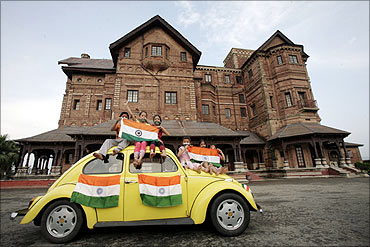 | « Back to article | Print this article |
This is the big and truly exciting story in India
Amidst the anguish about corruption -- and, one might add, the dirty tricks unleashed against those campaigning on the issue -- people have tended to forget that the big story in India, the truly exciting story, remains rapid economic growth.
That was underlined by the Planning Commission formally adopting on Thursday a 9-9.5 per cent annual growth target for the five years beginning next April -- building on the average of 7.8 per cent in the preceding 10 years.
The size of the middle class has exploded, and the poverty numbers have declined (you can argue by how much, but there is no credible statistical pattern of growth that says incomes double in a decade, and literacy climbs from 65 per cent to 74 per cent, but the absolute poor remain where they were.)
Get beyond the big macro numbers, and one sees what rapid growth means at the level of businesses.
Click NEXT to read on . . .
This is the big and truly exciting story in India
Did you know that India is now the second largest market in the world for elevators (after China, and ahead of the US)? So there are more high-rise buildings coming up in India than in any other country, barring China.
India also has more certified green buildings, ready or being built, than any other country barring the United States.
For that matter, did you know that Wal-Mart is growing its India business 60 per cent annually, that its stores often turn profitable in their first year, and that it may already be bigger than both Shoppers Stop and Trent?
Click NEXT to read on . . .
This is the big and truly exciting story in India
That Tata Consultancy Services is bigger today than the entire software sector was in 2002, and will hire almost as many people in one year as the total employed by Tata Steel across four continents?
And that the Indian motorcycle market is now the second largest in the world, while the car market is the sixth or seventh largest? Also, that India is among the top five markets for air-conditioners?
While Indian markets have become more open and competitive, and acquired scale (we may be talking of a $2 trillion economy this year), companies have become demonstrably more efficient.
Click NEXT to read on . . .
This is the big and truly exciting story in India
One indication: prices of manufactured goods have been going up less than general inflation.
Couple this with rising incomes, and you have halved the number of months' salary that it takes the average executive to buy a basic car. Ergo, dramatic growth in sales as the consuming class burgeons in numbers.
At the same time, companies have delivered greater surpluses; corporate savings have more than trebled in relation to GDP, from 2.7 per cent a decade ago to about 9 per cent (their share in total national savings has, therefore, doubled from 12 per cent to 25 per cent).
Click NEXT to read on . . .
This is the big and truly exciting story in India
This kicks into the macro story of more savings and investment, and therefore faster growth.
Finally, in yet another indicator of improved competitiveness, Indian exports have grown at an annual rate of 19 per cent through the past decade -- three times the global average of 6 per cent.
The conclusion seems inescapable: Corporate India's DNA has changed.
Click NEXT to read on . . .
This is the big and truly exciting story in India
Looking ahead, the McKinsey Global Institute has forecast that India will be the fifth largest consumer market by 2025.
That seems an understatement because, by the end of the next five-year Plan in 2017, India may already have become the fifth largest economy--overtaking the European trio of France, Britain and Italy.
So, even as the country grapples with in-your-face corruption and complex challenges in economic management, bear in mind that rapid economic growth, dramatic changes in Corporate India and a transformed quality of life for many millions, has been and remains the most compelling story of our times.






